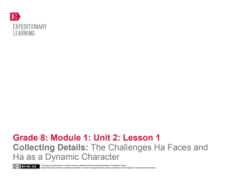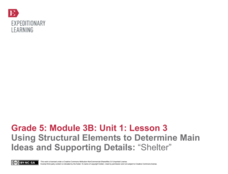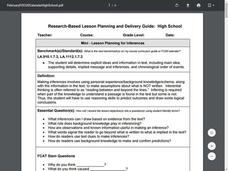Curated OER
Five Elements of a Story
Here’s a graphic organizer that permits learners to chart the introduction, rising action, climax, falling action and resolution of a story. The PDF file can be customized to work with any narrataive.
Polk Bros Foundation
I Can Analyze Cause and Effect
Examine cause and effect by asking pupils to fill out a basic graphic organizer. The template is for any story or event and provides a line for writing in the story or event title. Pupils write in two causes in the circles and the change...
Curated OER
Help Me Learn About the Holocaust
Young readers select a book from a provided list to use as the basis for an intensive class study of Holocaust novels. After completing their novels, groups create a multimedia presentation highlighting the elements of literature...
Curated OER
Mysterious Plot Problems
Your readers explore plot patterns in mysteries by identifying problems first in Two-Minute Mysteries by Donald J. Sobol and then in The Westing Game by Ellen Raskin. To gain access to the worksheets, graphic organizers and...
Curated OER
Recounts: Writing a Summary
Have your class review how to summarize a story. Learners discuss the way to write a summary and talk about the use of sequence words. The presentation uses a graphic organizer. This helps to make it a visually appealing presentation.
Curated OER
Venn Diagram for Compare/Contrast
Use this lesson to focus on a compare and contrast writing structure in your middle school language arts class. Here, young writers compare and contrast two texts using graphic organizers. They use a double bubble format for their...
Bright Hub Education
How to Outline, Plan & Write a Memoir
Get to know each individual through a memoir project. The lesson outlined here is a bit vague, but has some promising ideas for graphic organizers to help writers prepare their work. In order to succeed with the lesson, you will need to...
Student Handouts
Process Steps
A straightforward graphic organizer is a great way to outline steps for any subject. Kids fill out 10 steps to describe a process or brainstorm writing, with small arrows indicating that one step leads to the next.
EngageNY
Collecting Details: The Challenges Ha Faces and Ha as a Dynamic Character
What is a dynamic character? Using an interesting resource, scholars set out to answer the question. They create graphic organizers to collect details about character development as they read the novel Inside Out & Back Again. They...
EngageNY
Using Structural Elements to Determine Main Ideas and Supporting Details: “Shelter”
Does the picture tell the story? Learners continue their work in The Inuit Thought of It by creating a visual gist of pages 16 and 17. They then complete a main idea graphic organizer and discuss key supporting details.
English Worksheets Land
Party!
What could be more fun than two birthday parties in one day? Compare and contrast two parties with a short reading passage and a graphic organizer that focuses on character, setting, and events from the story.
State of Victoria Department of Education and Early Childhood Development
The Long Wall of China
While some aspects of the Great Wall of China are known, other parts of its story are obscured by time. A research lesson asks scholars to consider what we know and don't understand about this wonder of the world. The class then compiles...
Curated OER
Mini-Lesson Planning for Inferences
Making inferences and drawing conclusions is a key component to successful active reading. Encourage your class to use context clues and prior knowledge to infer different elements of a story, including the setting, plot, and character...
Curated OER
What's Special About Nonfiction?
Young scholars examine the difference between nonfiction and fictional writing. They identify the characteristics of nonfiction literature and examine how a nonfiction textbook organizes information.
Curated OER
Study Guide for Where the Red Fern Grows
One of the best fourth grade books of all time is Where the Red Fern Grows. Provide your class with interesting background on the book and the author as well as worksheets for every five chapters of the novel. The first part of the guide...
Curated OER
A Graphic Scene
Third graders discuss the advantages of using various graphic organizers including Venn Diagrams and T-charts. They use the organizers to compare and contrast different versions of classic mythological stories.
Curated OER
The Rest of the Story
Third graders make predictions about the story "The True Story of the Three Little Pigs" based on background knowledge. They read the story, stopping to verify or reject predictions. They write their own opinionated fairytales.
Curated OER
Planning a Story: The Great Sea Rescue
In this planning a story graphic organizer worksheet, students read the story starter and write the answers to the questions to help plan and complete the middle and ending. Students answer 8 questions and write the story.
Curated OER
Writing a Story: Planning
In this rewriting a familiar story worksheet, students choose a familiar story and fill in the squares of a graphic organizer with new information about the characters, setting, story starter, ending. and/or main events. Students write 5...
Curated OER
Silver Blaze and Other Stories
In this Silver Blaze and Other Stories reading and study guide worksheet, students respond to 8 multi-step short answer, multiple choice, and graphic organizer questions. The questions are designed to be answered before, while, and after...
Curated OER
Analyzing Story Structure
Young scholars explore language arts by completing a graphic organizer in class. In this story structure lesson, students read the poem "Sick" by Shel Silverstein and discuss the different elements in the piece which make it an...
Curated OER
STORY MAPPING: THE HUNDRED DRESSES
Young scholars illustrate and paraphrase each chapter of The Hundred Dresses, creating a graphic organizer through the use of story mapping. After students have completed their story maps, ask for a few volunteers to present theirs to...
August House
The Contest Between the Sun and the Wind
Learn the moral of the story with a series of activities about Aesop's fables. Focusing on The Contest Between the Sun and the Wind, learners complete a graphic organizer to discuss who, what, how, and why the events occur. Additionally,...
For the Teachers
Sequence Plot Chart
Your kids can identify the plot sequence of a short story, but what about an informational article? Have them examine the chronological order of events in informational texts with a activity on the sequence of events.























